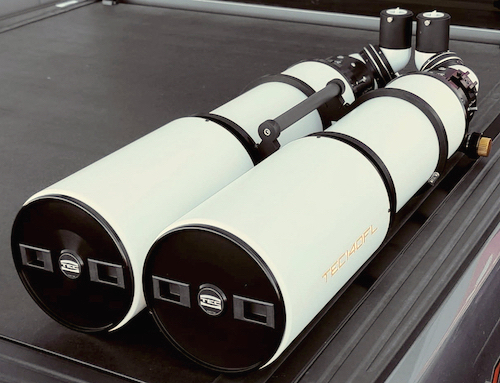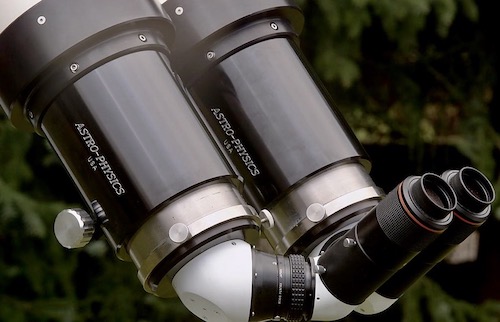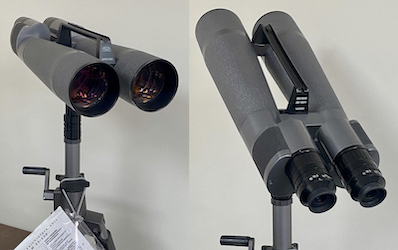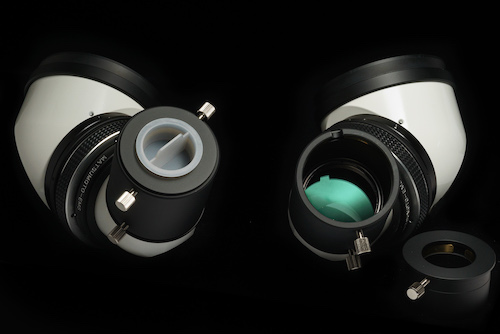

|
Telescope Engineering Company Binocular Telescopes Overview
BINOCULAR TELESCOPES ARE NOTHING NEW, JUST RARELY THIS GOOD
Binocular Telescope? Company Seven has decades of experience in optics and through these years we have looked at and observed through countless telescopes, large binoculars, and binocular telescopes. These have been produced by many companies and in various configurations. We know binocular telescopes are nothing particularly new, generations have observed firsthand how the capability to simultaneously and uniformly stimulate both eyes of an observer has several positive results, foremost are:
- sense of 3-D: the observer can obtain a better sense of depth leading to viewing in a more natural three-dimensions. This is often more of an illusion that true 3-D owing to the modest separation between the two objective lenses, but it is very convincing to the human brain.
- Lot's mo' betta: the observer may perceive detail in the object of study more clearly because by stimulating twice as much area of cones and rods in the human eye the brain receives cumulatively stronger signals thereby permitting them perceiving brighter views and with better clarity.
- When observing with both eyes then any floaters, those distracting particles suspended in the vitreous humor in the eye and that cast shadows onto the retina, tend to be averaged out by the processing that occurs in the brain. With binocular vision these tend to be less distracting, particularly to older observers who are more likely to have floaters.
- For most of our customers observing with two eyes is simply more naturally comfortable than squinting or covering one.
Click on image to see enlarged view (836,053 bytes)
The first aspect to consider is whether or not you are compatible with the binocular viewer; eye health and geometry of the face may preclude some from being able to use these. In addition to considering the impacts of the visual limited or experience, there are other factors to consider when deciding whether or not to opt for the binocular telescope solution. These can include comparing the views through one larger Apo telescope, possibly configured with a good binocular viewer, against what could be perceived with the binocular telescope. Also, the logistics, and costs of sourcing and dealing with a mount that can support either telescope or binocular telescope choices should be considered.
Some people out there pose a fairly superficial argument against the binocular telescope, they reason "why not simply use one larger telescope instead"; while this might suffice for observing the smaller objects including the Moon and the Planets, they fail to address another vital beneficial aspect of binocular telescopes. To overcome the benefit of a binocular telescope we generally compare what we can expect to observe in a single telescope equipped with a good binocular viewing accessory, versus what can be viewed through a binocular telescope of equal design and quality. For observing smaller objects in the single telescope we conclude this needs to be about 1.6 to 1.7 times larger in aperture, in order to surpass the detail and about equal brightness of objects that could be observed with a binocular telescope. So for example the TEC APO160FL binocular telescope should be surpassed by the APO200FL with a binocular attachment when observing objects within the respective field of the singe telescope. However, fields of view can be a really big factor especially for those who observe nebulae and larger objects, and this certainly does factor for terrestrial applications.
The field of view matters particularly when we consider Tatsuro Matsumoto of Japan developed, indeed nearly perfected, a system of paired mirrored devices that allows a user with two parallel telescopes normal stereoscopic vision. A great benefit of these is their capacity to accommodate up to 2 inch (50.8 mm) diameter eyepieces.
Left: paired Astro-Physics 180mm f/9 Apos configured as a Binocular Telescope, with 4 inch focusers and paired 2 inch diameter eyepieces. This system was put together in 2002 by our customer in Europe, Mr. H. Wengler. This arrangement was made more practical by Mr. Matsumoto's EMS system (explained below) allowing up to 2 inch eyepieces (49,089 bytes).
Click on image to see enlarged view (116,751 bytes)
If one employs our best quality of view binocular accessory, then this supports only up to 1.25 inch (31.7 mm) diameter eyepieces. Company Seven has measured and tested the eyepieces we offer, and we have very good understandings of their strengths and weaknesses. From our database we can compare what one may expect to observe through the various eyepieces and we teach customers they can expect to see 2.9x the area the area of sky in the widest field of view 2 inch eyepiece, compared to the widest field possible in 1.25 inch eyepieces. In other words, if you are limiting a telescope to 1.25 inch eyepieces, instead of using 2 inch, then you can see only about 35% of the area possible. Inversely the potential field of view with a 2 inch eyepiece is 2.87x the area of 1.25 inch. So, a single telescope configured with a good binocular viewer enters the competition with a 35% disadvantage just based on that math.
Comparing for example the TEC APO200FL with a binocular viewing attachment equipped with the widest field of view 1.25 inch eyepieces, this could be expected to show just under 1 degree actual field of view. If the binocular viewer is equipped with Baader Glaspath Compensator lens, for their most perfect views, then the APO200FL could show just under ½ degree field of view at about 167x. The APO160FL binocular telescope, built with Mr. Matsumoto's EMS system, is able to accept 2 inch eyepieces. So the APO160FL binocular telescope could show 1.65 degrees of sky at a low of 29x with common first-rate 2 inch eyepieces.
So answers to this debate are not so clear cut, and this is in good measure why we prefer to speak with, or meet you, at our showroom.
A Little History: going back to the end of the 19th century binoculars tended to incorporate built-in Porro prisms to present the observer with an image that was right-side up, and correct left to right. To provide greater magnification and increased light-gathering power this mandated larger and larger objective lenses, so companies including Carl Zeiss Jena of Germany developed larger aperture hand-holdable binoculars. Initially these larger binoculars were basically the back half of a conventional Porro binocular, mated to a front barrel that tapered out to a larger diameter housing the bigger objective lens; many 70mm and larger aperture binoculars of today still resemble this arrangement.
Between 1897 and the mid 1970s the Astro Division of Carl Zeiss Jena, at Jena and Eisfeld in Germany produced some of the world's best and largest binocular telescopes. Their military handhold able binoculars and their binocular refracting telescopes too were marketed as “doppelfernrohr” (double telescope), often marked with the abbreviation “D.F.”. Some large observatory models were configured as doppelfernrohr, and some “dreifaches fernrohr ” (triple telescope) arrangements were produced. The joining of two smaller telescopes in parallel could allow true binocular viewing experiences, or for larger models they could be similar of different in size and even in design so a refractor in parallel to a Cassegrain telescope for example could permit one to guide the other during long exposure imaging, or could accommodate various sensing instruments to operate in tandem.
Building a binocular that had only one fixed fixed higher magnification posed practicality issues, especially with the relatively narrow field of view eyepiece designs of this era the user might have a difficult time finding and centering the binocular onto a distant object, or if the user was on a small boat or a larger vessel in rough waters getting any use from a fixed higher power binocular could be impossible. So, these early designers came up with the 'turret' arrangement; this is where the rear of the binocular, behind each image erecting prisms housing, incorporates a rotatable eyepiece holder with two or more eyepieces each. Carl Zeiss Jena was among the few companies to make this work when in 1896 the Zeiss introduced a new binocular that derived from their 10x 25 mm model introduced in 1895, this was the “Marine-Glas”. This new binocular is useable at 5x and by rotating the turrets over each prism cover the user could dial another eyepiece in-line to operate at 10x. Soon after then larger aperture models followed, these larger turret model binoculars were engineered to be tripod mounted. Zeiss opticians were able to fashion pretty fast achromatic lenses of up to about 80mm aperture that perform well enough to suit the magnifications and relatively compact forms intended for these binoculars. These featured two or three eyepiece per turret arrangement, and were provided with an adjustable height wood field tripod; the binocular or possibly the entire set would have been sold in a wood case. The early production Carl Zeiss Jena “Asembi” 80mm binocular featured magnifications of 12, 20, and 30x. Soon after they were able to be produced with 12, 20 and 40x.

Rear turrets and side views of a
Note the three eyepieces on each turret. This example was produced in 1910 and is in Company Seven's showroom collection (99,204 bytes).
Click on image to see to see enlarged view (257,987 bytes).
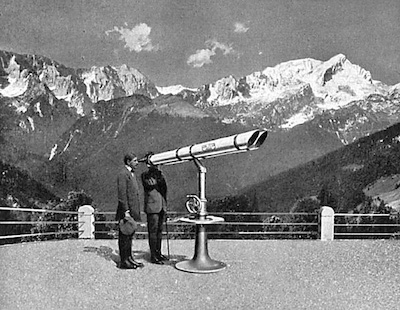 The Carl Zeiss Jena 80mm models were recognizable as large binocular, but beyond these the even larger models more closely resembled paired telescopes. To deliver even greater magnifications with brighter images they developed binocular telescopes that were truly paired telescopes, assembled and precisely aligned in parallel. These included the 33, 52 and 72x 110mm “Asaltur”, and their 25, 58 and 116x “Asal” of 130mm shown in the Zeiss Astronomical Instruments Catalogs of the 1920s and 1930s. They produced even larger binocular telescopes of up to 240 mm. These were initially sold for terrestrial observing, most often at mountain lodges where the observers could study sights in the distance, even track parties of mountain climbers. For terrestrial observing these would incorporate built-in Porro prisms to present an image that was right-side up, and correct left to right. These operated within modest demands, in terms of magnifications, so their objective lenses tended to have a shorter focal length than those intended for astronomy. Owing to the lens tech of their day these were physically very long relative to their apertures, typically on the order of f/10 to f/15. The 110 mm “Asaltur” for example, with its 4.3 inch diameter objective lens has an 51 inch focal length, this compares to the focal length of about 65 inches for the conventional Zeiss 110mm astro telescope of that era. These were very long heavy, constructed with optical tubes of steel and brass consequently these mandated massive tripod or pier and head arrangements to support them.
The Carl Zeiss Jena 80mm models were recognizable as large binocular, but beyond these the even larger models more closely resembled paired telescopes. To deliver even greater magnifications with brighter images they developed binocular telescopes that were truly paired telescopes, assembled and precisely aligned in parallel. These included the 33, 52 and 72x 110mm “Asaltur”, and their 25, 58 and 116x “Asal” of 130mm shown in the Zeiss Astronomical Instruments Catalogs of the 1920s and 1930s. They produced even larger binocular telescopes of up to 240 mm. These were initially sold for terrestrial observing, most often at mountain lodges where the observers could study sights in the distance, even track parties of mountain climbers. For terrestrial observing these would incorporate built-in Porro prisms to present an image that was right-side up, and correct left to right. These operated within modest demands, in terms of magnifications, so their objective lenses tended to have a shorter focal length than those intended for astronomy. Owing to the lens tech of their day these were physically very long relative to their apertures, typically on the order of f/10 to f/15. The 110 mm “Asaltur” for example, with its 4.3 inch diameter objective lens has an 51 inch focal length, this compares to the focal length of about 65 inches for the conventional Zeiss 110mm astro telescope of that era. These were very long heavy, constructed with optical tubes of steel and brass consequently these mandated massive tripod or pier and head arrangements to support them.
A Carl Zeiss Jena model Asal 130 mm achromatic binocular telescope with image erecting Porro Prisms, on an alt-az pedestal mount. Shown at mountain overlook in Europe c. 1919 (66,318 bytes).
Click on image to see to see enlarged view (257,987 bytes).
The approach of World War II changed the development path of optics. Most binoculars that had been produced through the late 1920s incorporated eyepieces of designs that were nothing particularly remarkable by this day and age. However, going into World War II the demands, particularly by the German, Japanese, and United States military, gave rise to some amazing and wide-angle binoculars. As good and as ruggedly constructed many of these were, they were for the most part fixed-magnification models though some made provisions for changing magnifications by dialing in internal mechanisms. More light gathering power, wider fields of view and robust construction to survive military use gave rise to notably improved larger binoculars that could be used not only to spot soldiers or aircraft in the distance, but that could be pointed up to see the night sky.
Military model optics were relatively mass produced and improved, including the German D.F. 10x 80 mm and 25x 105 mm Flak binoculars that originated by the mid 1930s. The Imperial Japanese Navy had since the mid 1930s been explicitly trained in night combat, so their capital ships featured some of the largest binoculars that had been made, including the Nikko 18.8x or 20x 150 mm Porro II binoculars that with a Cooke triplet objective lens was surprisingly compact and allowed a true field of view (15 18.8x) of about 3 degrees wide! The IJN produced even larger models, including a 180 mm and up to their 33x 200 showing 1.8 degrees, with a folded optics arrangement this has an overall length of only 31 inches! The US military would eventually join in and develop some good binoculars up to 120 mm. However, the most notable US products were some amazing hand-holdable models of the US Navy: 7x 50 mm Mark 41 by Bausch & Lomb, and the 6x 42 mm Mark 43 by SARD, both exhibited at Company Seven. But in terms of presence and performance nothing for years to come would rival the Carl Zeiss Jena D.F. 20+40x 200mm binoculars produced later in the war; notice our mention of “for years to come”.
More recently: there have been very good, hand-holdable binoculars made with apertures larger than those of many of the smaller amateur telescopes. While binoculars on the order of 7x or 8x with apertures of 50mm to 60mm were considered good choices for low light applications, and 7x 50 models such as the Fujinon 7x 50 mm FMTRC-SX came to dominate the marine and astronomy markets, we have sold higher magnification 60 mm models that are practical and hand-holdable. The peak of performance of larger conventional binoculars include Carl Zeiss 15x 60mm B/GA binocular that were discontinued in the fall of 1998, the unrivaled
At right is one of the few exceptions: Carl Zeiss Jena “Aspectem” 20 to 50x Vario (zoom) 80mm, assembled at the former Carl Zeiss Jena Eisfeld plant, and one of their very last binoculars produced. In Company Seven's showroom collection (101,900 bytes).
We do offer some modern binoculars that feature selectable magnifications, and that are quite good. These are the Leica Duovid 8 + 12 x 42 and Leica Duovid 10 + 15 x 50 binoculars introduced here in 2002. Again, these are made to be compact and to work within limits that makes them hand holdable for most healthy adults.
Now, getting back to binocular telescopes, there never really was a firm definition of where a 'binocular' ends, and a 'binocular telescope' begins. But we at Company Seven point to some hints, to our mind a binocular telescope for astronomy shares ALL of these distinct properties:
But putting together two large astronomical telescopes, ones that would impress the connoisseur of today, was no easy feat.
Then Came Lee Cain, then Jim Burr: amateur astronomers have been known to develop “Aperture Fever”, this is condition where no matter what they use today they desire to observe celestial objects even brighter, sharper, and clearer. This leads to increasing expenditures for larger or better made, or larger and better made, telescopes. Of course, the condition can become progressive, so where no matter what next telescope you buy, in a year or a few years you will be wanting to see even more and this results in the endless loop of buying bigger to see objects brighter, sharper, and clearer.
Lester Lee Cain, Jr. (1948-2021) was a life-long Texan whose interests included amateur astronomy. By the 1980s he made notable inroads to popularizing visual astronomy, and for decades he was a member of and indeed contributed to the development of the Houston Astronomical Society. The big binoculars of the 1980s, even the well regarded Fujinon 150 mm binocular models up to and including the later Fujinon 150 with night vision, were either too costly or insufficient. Desire and competence led Mr. Cain to be among the first to successfully bring together two economically constructed Newtonian optical systems, configured with Dobson style principles, to work as one binocular telescope. His first notable 13.1 inch binocular telescope grew, and the technology if his models also improved. Especially in Texas skies there was a lot to be said for what could be seen with these instruments, they truly do give an amazing sense of 3-D perception. Mr. Cain dealt with some of the complicated aspects of making this work and making them practical, with techniques and materials that require some bit of dedicated understanding and patience on the part of the owner of those systems. Mr. Cain demonstrated his 13.1, then by the summer of 1984 he was sharing his 17.5 inch, a highly refined reverse binocular, to astonished viewers at numerous Star Parties in the USA. These binocular telescopes, and Mr. Cains generosity enabled dramatic improvements to how those with whom he shared them perceived the night sky.
Getting to the point of why we mention them here, JMI developed and built the Reverse Binocular series reflecting telescopes. As we mentioned above, these were not an entirely new concept since Lee Cain and others too has made their own binocular telescopes, with apertures ranging from 10 inch to greater than 20 inches. However, in the Spring of 2003 with the introduction of the 6 inch f/5 RB-66 JMI became the first manufacturer in the world to make the concept refined and practical, and transportable by the enthusiast. The RB line increased to offer models in apertures of 6, 10 and and 16 inch. Similar to those pioneered by Lee Cain, one positioned themselves between the binocular barrels and tended to look onto the eyepieces with diagonals that made observing pretty comfortable; these also featured motorized focusing and IP spacing settings, even the option of encoders with digital setting circles.
Right: JMI RB-66 6 inch Reverse Binocular Telescope, exhibited at Company Seven (102,682 bytes).
As conveyed to us by one of our local customers, a pretty experienced mature observer, at a star watch event in our region:
JMI and Company Seven sold the 6, 10, and 16-inch Reverse Binocular Telescope models until shortly before JMI was acquired by another company. Since the sale of the JMI company there had been no reasonable alternative binocular reflecting telescopes, or refracting telescopes either.
Erecting Mirror System (EMS), or 'bino backs' are the the critical accessory that that permitted Yuri at TEC to develop their Binocular Telescope series. The EMS are paired, mirrored devices developed by Tatsuro Matsumoto of Japan that provide most users of two parallel telescopes the luxury of normal stereoscopic vision. Mr. Matsumoto has been involved for decades as an amateur astronomer, and developer of accessories. His article about making homemade binoculars appeared in the November 1982 issue of the Sky & Telescope magazine. By 1989 he commenced developing these EMS so he has had many years to refine, indeed perfect, his craft.
Right: Erecting Mirror System (EMS) paired set, developed by Tatsuro Matsumoto of Japan allowing two telescopes to operate as a binocular.
The EMS bino backs attach onto the rear of each binocular telescope focuser. The EMS's cylindrical housing incorporates two mirrors, and with swiveling joints the user can divert the cone of light exiting the telescopes towards and into the eyepieces. Their broad range of lateral shift accommodates the largest practical amateur binocular telescopes. The proper arrangement of the EMS onto the telescopes combine with adjustability of the EMS's to adjust interpupillary spacing to suit the observer. These place both eyepieces, in parallel, at a right-angled orientation to the telescope and helps to keep the observer's orientation to the eyepieces comfortable. To insure nominal performance, the alignment of the mirrors in the left and right units must correspond, so the right EMS unit incorporates an X-Y axis image shifting mechanism to facilitate this collimation, that is the merging both the images into one. This can be accomplished with such precision that even when operating at the highest practical magnifications one obtains a sharp clear image.
The initial assembly and installation are critical in obtaining proper back focus and collimating the beams so they both appear as one image to the observer. After factory installation and collimation are completed, then these are pretty rugged. However, should a system be hammered by shippers or dropped and knocked out of collimation then the user can, with some guidance, collimate the set. Of course Company Seven remains available to assist our customer.
Being mirror systems there is no distracting roof edge line, such as might be visible in a roof prism system. Nor is there the weight (and cost) penalty associated with Porro prisms that would be large enough to support 2 inch eyepieces.
A major factor in favor of the Matsumoto EMS is their capability to support not only paired 1.25 inch diameter, but up to 2 inch diameter eyepieces as well. However, this is not to say everybody can use the 2 inch eyepieces as some people will not be able to bring two eyepieces close enough together to align their exiting cones of light into both eyes: this is dependent on the individual's interpupillary spacing, and to some degree on the overall outer diameter of the 2 inch eyepiece. Company Seven does offer a range of 1.25 inch and 2 inch eyepieces, many which are good choices for use on the binocular telescope. We have modified some paired larger 2 inch eyepieces to suit some of our clients. We do mean paired as otherwise there can be differences between identically labeled eyepieces, and we know to look for these. These are among the reasons why we at Company Seven prefer to discuss this possible solution with our customer, or even meet with them at our showroom.
TEC binocular telescope optical tubes are engineered to accommodate the back focus light path, and the weight of the EMS, plus weight of the eyepieces.
Of course, their overarching consideration is the quality of their binocular views, achieved not only the diffraction-limited resolution. Short of those top line products such as ones made by Carl Zeiss Jena, most consumer oriented large binoculars are not recommended for use at the high magnifications most of us would prefer to planetary observing; this is for not only due to limits of their collimation that would need to approach about 0.5 arc-second alignment, but also due to the optical qualities that rarely support this.
Take Company Sevens word for it, these EMS are good! But regardless of how good the EMS and the TEC APO binocular telescopes are, keep in mind their great attributes remain:
Also factor, that whenever sharing a binocular telescope or a telescope that incorporates a binocular viewing accessory, these are a little bit more work to set up for each observer as not only does IP spacing need to be set, but there may be diopter differences that must be adjusted when configuring the instrument for each individual. Over the decades we at Company Seven have made available many of our best telescopes for public observing sessions; but because of the additional steps to configure parallel eyepieces for each novice we tend to bring out binocular arrangements to the general public only for those most special events where people who line up may be more patient (a great comet, or a particularly good planet opposition, Shoemaker-Levy hitting Jupiter, etc.) for which the binocular experience can be mesmerizing!
Click on image to see enlarged view (356,332 bytes).
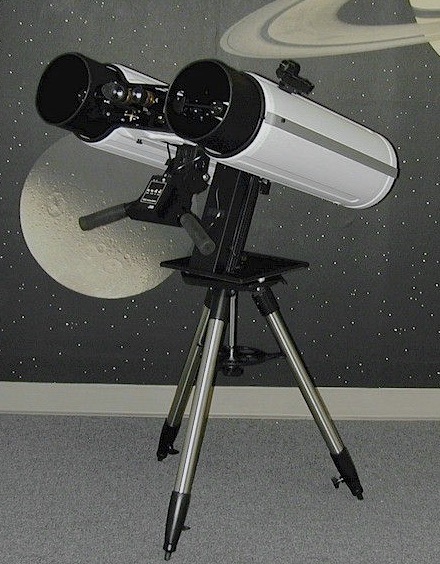
Meanwhile, in Colorado Jim Burr had founded a small business “Jim's Mobile Color TV Shop” started in the fall of 1970. By the early 1980s the amateur astronomer had become so involved with tinkering solutions for his telescopes that he started advertising in amateur astronomy magazines as Jim's Mobile, Inc. (JMI). His company moved into devising and manufacturing numerous economical and practical solutions for amateur astronomers. Soon after, Company Seven became an authorized retailer, and we would recommend and exhibit examples of many JMI products. His ideas included motorized focusers that could be added to popular telescopes of the day, lightweight plastic shell molded carry cases for these telescopes, dollys specifically well suited for telescopes that are still marketed as the #8220;Wheeley Bar”. JMI developed a selection of telescopes based on the Newtonian reflecting arrangement, including their “New Generation Telescope (NGT)”.
Click on image to see enlarged view (172,561 bytes)
Then Came Tatsuro Matsumoto, and Yuri
Image courtesy of Mr. Matsumoto (97,163 bytes).
Click on image to see enlarged view (179,170 bytes).
Right: Yuri Petrunin holding a binocular APO140FL (76,977 bytes).
TEC REFRACTING BINOCULAR TELESCOPES
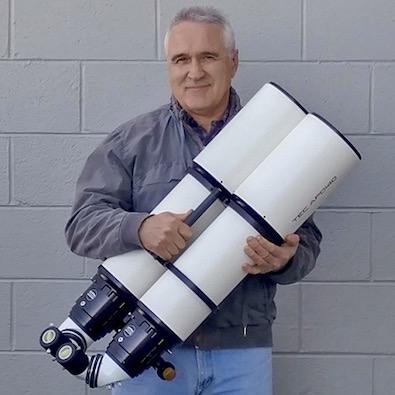
Feel free to contact Company Seven, or visit the only Apo central in America to see these telescopes firsthand Company Seven's showroom.
Contents Copyright 1994-2024 Company Seven All Rights Reserved


